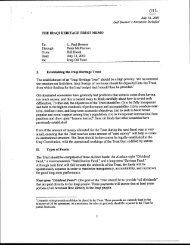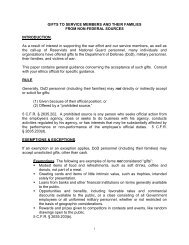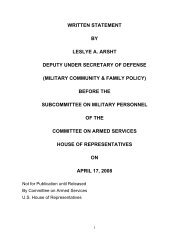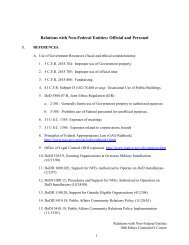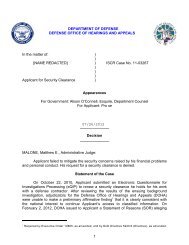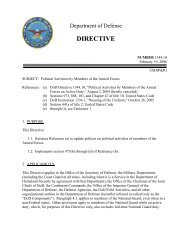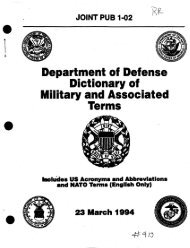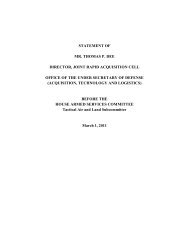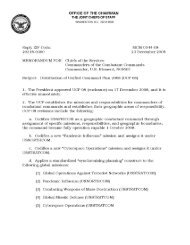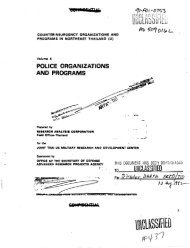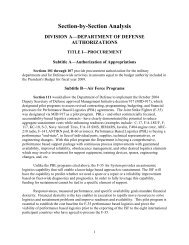dod tactical herbicide sites - United States Department of Defense
dod tactical herbicide sites - United States Department of Defense
dod tactical herbicide sites - United States Department of Defense
You also want an ePaper? Increase the reach of your titles
YUMPU automatically turns print PDFs into web optimized ePapers that Google loves.
The Distinction Between Tactical and Commercially ApprovedHerbicides Used in the Vietnam WarThere exists significant confusion as to how <strong>herbicide</strong>s were selected by the military to beused in the defoliation program in the Vietnam War The belief that commerciallyavailable <strong>herbicide</strong>s were simply purchased from the chemical companies and deployeddirectly to Vietnam is incorrect and contrary to historical records.The Military Development and Deployment <strong>of</strong> Tactical HerbicidesTactical Herbicides were <strong>herbicide</strong>s developed specifically by the <strong>United</strong> <strong>States</strong><strong>Department</strong> <strong>of</strong> <strong>Defense</strong> to be used in “combat operations”. The history <strong>of</strong> the militarydevelopment and evaluation <strong>of</strong> <strong>tactical</strong> <strong>herbicide</strong>s was described in the previous section.The testing <strong>of</strong> large volume aerial systems in 1952 and 1953 using Air Force B-29, B-50,and C-119 aircraft, and spraying a mixture <strong>of</strong> 2,4-D and 2,4,5-T, proved that militaryaircraft and <strong>tactical</strong> <strong>herbicide</strong>s could be potentially used in a combat environment. Themission to develop additional <strong>tactical</strong> <strong>herbicide</strong>s and new delivery technology wasassigned to the US Army Chemical Corps, and specifically to the Crops Division <strong>of</strong> theBiological Warfare Laboratories (subsequently, the Plant Sciences Laboratories) at FortDetrick, Maryland. The program involved the evaluation <strong>of</strong> thousands <strong>of</strong> compounds forherbicidal activity. In addition, the US Army with the active participation <strong>of</strong> the AirForce and Navy continued engineering development <strong>of</strong> delivery technology. When theAir Force accomplished prove-out and acceptance testing <strong>of</strong> the large-capacity (1,000gallons) spray system (known as the MC-1 or Hour-glass Spray System) it wasimmediately sent to Guam, along with 5,000 drums <strong>of</strong> a concentrated mixture <strong>of</strong>technical butyl esters <strong>of</strong> 2,4-D and 2,4,5-T called “Purple”, although neither the SpraySystems or the <strong>herbicide</strong>s were used. After the close <strong>of</strong> the Korean Conflict, Fort Detrickscientists were involved in 1957 with tests showing the herbicidal activity <strong>of</strong> cacodylicacid (an organic arsenical) on rice and grasses, and with the evaluation <strong>of</strong> aerialapplication tests with mixtures <strong>of</strong> 2,4-D and 2,4,5-T at Fort Ritchie, Maryland (1956),Dugway, Utah (1959), and Fort Drum, New York (1959) (see Leaflets 6, 7, and 8).In early 1961, the US military initiated Project AGILE, a project designed to providetechnical information on the chemical means <strong>of</strong> controlling vegetation that could beapplied to military operations in South Vietnam. The <strong>tactical</strong> problem to which researchwas directed was the development <strong>of</strong> chemicals that could rapidly control a broad range<strong>of</strong> botanical species. Once again the <strong>Department</strong> <strong>of</strong> the Army’s Plant SciencesLaboratories at Fort Detrick, Maryland was given the responsibility, but this time the goalwas to determine the technical feasibility <strong>of</strong> defoliating jungle vegetation in SouthVietnam.7



